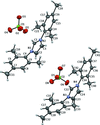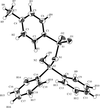issue contents
April 2019 issue

Cover illustration: In the crystal structure of 2,8-dimethyl-5,11-bis[3-(methylsulfanyl)propyl]-1H,7H-diimidazo[c,h][1,6]diazecine, large voids of ca 100 Å3 are present, which are apparently not filled with solvent molecules. The refinement was challenging because of twinning and disorder as well as these voids. See: Gasque, Zermeño & Bernès [IUCrData (2019). 4, x190441].
metal-organic compounds
Download citation


Download citation


Open  access
access
 access
accessThe reaction between equimolar amounts of propane-1,3-diamine and molybdenum trioxide in water led to the formation of single crystals of the title salt, (C3H12N2)[MoO4]. The asymmetric unit comprises of one propane-1,3-diammonium cation and one molybdate anion. The latter is isolated in the structure and has a slightly distorted tetrahedral configuration. An extensive network of N—H⋯O hydrogen bonds connects anions and cations, giving rise to a compact three-dimensional packing.
CCDC reference: 1909766
Download citation


Download citation


Open  access
access
 access
accessThe reported monocluear GdIII complex belongs to an isotypic lanthanide series in which the metal centre is 8-coordinate, and crystallizes with ethanol as lattice solvent.
CCDC reference: 1909306
Download citation


Download citation


Open  access
access
 access
accessIn the title compound, [Fe(C17H12Br)2], the five-membered rings sandwiching the iron atom are almost perfectly eclipsed.
CCDC reference: 1849488
organic compounds
Download citation


Download citation


Open  access
access
 access
accessA new polymorph of N-[5-(diphenylamino)penta-2,4-diyn-1-yl]benzamide is reported.
CCDC reference: 1903693
Download citation


Download citation


Open  access
access
 access
accessThe two independent molecules of the title compound differ in the orientation of the phenyl rings with respect to the plane of the triazine ring. In the crystal, molecules are linked by classical N—H⋯N hydrogen bonds to form chains parallel to the b axis.
CCDC reference: 1904090
Download citation


Download citation


Open  access
access
 access
accessThe asymmetric unit of the title compound contains three independent molecules which, weak C—H⋯π interactions link the molecules.
CCDC reference: 1899622
Download citation


Download citation


Open  access
access
 access
accessThe reported thiophene derivative is asymmetrically substituted, with an imine group and a phenylethynyl group.
CCDC reference: 1903308
Download citation


Download citation


Open  access
access
 access
accessThe crystal of the title compound features N—H⋯S hydrogen bonds, which generate (000) layers.
CCDC reference: 1906787
Download citation


Download citation


Open  access
access
 access
accessIn the crystal structure of the title compound, large voids of ca 100 Å3 are present, which are apparently not filled with solvent molecules.
CCDC reference: 1907206
Download citation


Download citation


Open  access
access
 access
accessThe crystal structure of the title compound has been characterized by single-crystal X-ray diffraction and by IR, UV, and 1H NMR spectroscopic techniques. The molecule resides on a crystallographic twofold axis, which leads to disorder of the H atoms on the methyl group attached to the benzene ring.
CCDC reference: 1904010
Download citation


Download citation


Open  access
access
 access
accessThe molecular and crystal structure of a perchlorate salt of the 1,3-bis(2,4,6-trimethylphenyl)imidazolium cation is reported.
CCDC reference: 1909297
Download citation


Download citation


Open  access
access
 access
accessThe title compound is a benzoin with a bulky substituent on the alcohol group. The conformation in the crystal structure is similar to that found for the unsubstituted benzoin.
CCDC reference: 1908808
Download citation


Download citation


Open  access
access
 access
accessThe absolute structure of D-glutamic acid hydrochloride has been determined by single-crystal X-ray diffraction at room temperature using Cu Kα radiation.
CCDC reference: 1515166
Download citation


Download citation


Open  access
access
 access
accessThe structure of the title compound, a dihydroxylated metabolite of 3,4-dichlorobiphenyl (PCB 14)features π–π stacking interactions between inversion-related chlorinated benzene rings
CCDC reference: 1910304
Download citation


Download citation


Open  access
access
 access
accessIn the title compound, the configuration around the sulfur atom of the sulfonediimine group is a slightly distorted tetrahedron with two S=N bonds and two S—C bonds. In the crystal, molecules are connected by pairs of N—H⋯O hydrogen bonds, forming inversion dimers with an  (12) ring motif.
(12) ring motif.
CCDC reference: 1452477
Download citation


Download citation


Open  access
access
 access
accessThe title compound, a rare example of a spirocyclic orthoamide, was synthesized by a double cyclization of a N-Boc protected sarcosine derivative. The crystal structure of the racemic (R,R/S,S) modification reveals two near-orthogonal five-membered heterocyclic ring systems, each in an envelope configuration.
CCDC reference: 1486263
Download citation


Download citation


Open  access
access
 access
accessIn the title compound, the dihedral angle between the fluorene moiety and the chlorophenyl ring is 64.59 (6)° and a possible weak intramolecular C—H⋯π interaction occurs.
CCDC reference: 1911702


 journal menu
journal menu




























![[publCIF]](/logos/authorchecklist11.gif)





